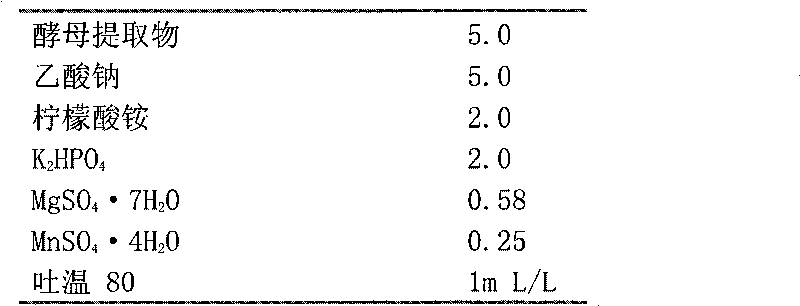Low temperature fermentation inoculum for preparing straw feed
A technology for fermentation inoculum and straw feed, which is applied in the field of low-temperature fermentation inoculants, can solve the problems of no straw feed fermentation inoculum, restriction on the activity of lactic acid bacteria, etc., so as to achieve the advantages of improving nutritional value and palatability, improving fermentation quality and reducing pH value. Effect
- Summary
- Abstract
- Description
- Claims
- Application Information
AI Technical Summary
Problems solved by technology
Method used
Image
Examples
Embodiment 1
[0015] Embodiment 1, the screening of active ingredient in fermented inoculum
[0016] Composition of R-MRS medium (g / L):
[0017]
[0018]
[0019] Crush the rice stalks from the rice-producing areas in Northeast China into 1-2 cm long pieces, add 0.5 g each of the above-mentioned rice stalks, the soil from this area, and the mixture of the above-mentioned rice stalks and soil into 10 ml of R-MRS medium Medium, anaerobic culture in a 5°C refrigerator. After 10 days, 15 μl of each of the above three types of culture solutions were respectively inoculated into 300 ul of fresh R-MRS medium, transferred once every 4 days, and subcultured continuously. The pH value of the culture medium and the production of lactic acid were measured. Select a culture whose pH value drops rapidly, produces more lactic acid and is relatively stable to changes in the external environment, and screens for active ingredients.
[0020] The culture obtained above was studied by establishing a 1...
Embodiment 2
[0021] Embodiment 2, the preparation of the low-temperature fermentation bacterial agent that is used to prepare straw feed
[0022] Lactobacillus sakei JCM 1157 and Leuconostoc inhae KCTC 3774 were purchased from the Japan Microorganism Conservation Center and the Gene Bank of the Korean Institute of Biotechnology, respectively.
[0023] 1. Preparation of low-temperature fermentation bacterial agent for preparing straw feed
[0024] Lactobacillus sakei (Lactobacillus sakei) JCM 1157 and Leuconostocinhae (Leuconostocinhae) KCTC 3774 were inoculated into R-MRS medium respectively, cultured at 10°C for 24 hours, and 79ml of the above-mentioned Lactobacillus sakei (Lactobacillus sakei) JCM The fermented liquid of 1157 is mixed with the fermented liquid of 21ml above-mentioned Leuconostoc inhae (Leuconostoc inhae) KCTC 3774, and in the mixed fermented liquid, the fermentation liquid of Lactobacillus sakei (Lactobacillus sakei) JCM 1157 and Leuconostoc inhae (Leuconostoc inhae) KCT...
Embodiment 3
[0030] Embodiment 3, the preparation of the low-temperature fermentation bacterial agent that is used to prepare straw feed
[0031] Lactobacillus sakei JCM 1157 and Leuconostoc inhae KCTC 3774 were purchased from the Japan Microorganism Conservation Center and the Gene Bank of the Korean Institute of Biotechnology, respectively.
[0032] 1. Preparation of low-temperature fermentation bacterial agent for preparing straw feed
[0033]Lactobacillus sakei (Lactobacillus sakei) JCM 1157 and Leuconostocinhae (Leuconostocinhae) KCTC 3774 were inoculated into R-MRS medium respectively, cultured at 10°C for 24 hours, and 70ml of the above-mentioned Lactobacillus sakei (Lactobacillus sakei) JCM The fermented liquid of 1157 is mixed with the fermented liquid of 20ml above-mentioned Leuconostoc inhae (Leuconostoc inhae) KCTC 3774, and in the mixed fermented liquid, the fermentation liquid of Lactobacillus sakei (Lactobacillus sakei) JCM 1157 and Leuconostoc inhae (Leuconostoc inhae) KCTC...
PUM
 Login to View More
Login to View More Abstract
Description
Claims
Application Information
 Login to View More
Login to View More - R&D
- Intellectual Property
- Life Sciences
- Materials
- Tech Scout
- Unparalleled Data Quality
- Higher Quality Content
- 60% Fewer Hallucinations
Browse by: Latest US Patents, China's latest patents, Technical Efficacy Thesaurus, Application Domain, Technology Topic, Popular Technical Reports.
© 2025 PatSnap. All rights reserved.Legal|Privacy policy|Modern Slavery Act Transparency Statement|Sitemap|About US| Contact US: help@patsnap.com


